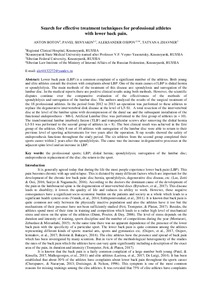Search for effective treatment techniques for professional athletes with lower back pain
URI (для ссылок/цитирований):
https://efsupit.ro/images/stories/martie2018/Art%202.pdfhttps://elib.sfu-kras.ru/handle/2311/111577
Автор:
Anton, Botov
Pavel, Shnyakin
Osipov, A.
Tatyana, Zhavner
Коллективный автор:
Институт филологии и языковой коммуникации
Институт физической культуры, спорта и туризма
Кафедра иностранных языков для инженерных направлений
Кафедра физической культуры
Дата:
2018-03Журнал:
Journal of Physical Education and SportКвартиль журнала в Scopus:
Q3Библиографическое описание:
Anton, Botov. Search for effective treatment techniques for professional athletes with lower back pain [Текст] / Botov Anton, Shnyakin Pavel, A. Osipov, Zhavner Tatyana // Journal of Physical Education and Sport: 2. — 2018. — Т. 18 (№ 1). — С. 17-22Аннотация:
Lower back pain (LBP) is a common complaint of a significant number of the athletes. Both young and
elite athletes consult the doctors with complaints about LBP. One of the main causes of LBP is diskal hernia or
spondylolysis. The main methods of the treatment of this disease are: spondylosis and surrogation of the lumbar
disc. In the medical reports there are positive clinical results using both methods. However, the scientific
disputes continue over the comparative evaluation of the effectiveness of the methods of spondylolysis and
surrogation of the lumbar disc. The authors analyzed the results of the surgical treatment of the 18 professional
athletes. In the period from 2012 to 2013 an operation was performed to these athletes to replace the
degenerative intervertebral disk disease at the level of L5-S1. A total resection of the intervertebral disc at the
level of the lumbar spine with decompression of the dural sac and the subsequent installation of the functional
endoprosthesis - M6-L Artificial Lumbar Disc was performed to the first group of athletes (n = 10). The
transforaminal lumbar interbody fusion (TLIF) and transpedicular screws after removing the diskal hernia L5-S1
was performed to the second group of athletes (n = 8). The best clinical result was achieved in the first group of
the athletes. Only 8 out of 10 athletes with surrogation of the lumbar disc were able to return to their previous
level of sporting achievements for two years after the operation. X-ray results showed the safety of
endoprosthesis functions throughout the study period. The six athletes from the second group completed their
sports career within 2 years after the spondylolysis. The cause was the increase in degenerative processes at the
adjacent spine level and an increase in LBP.

